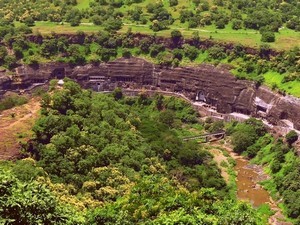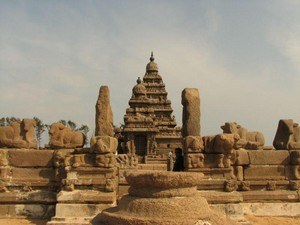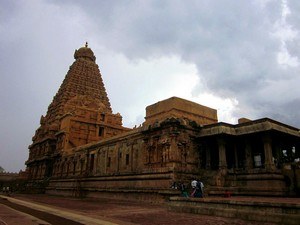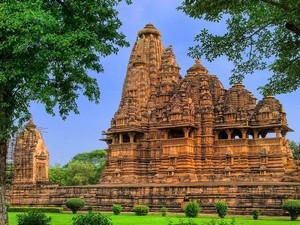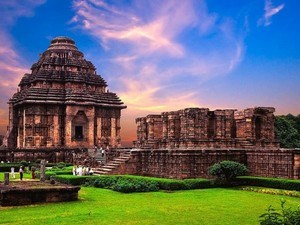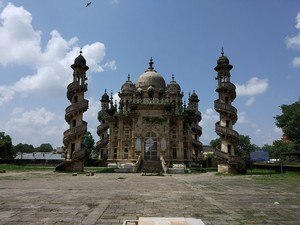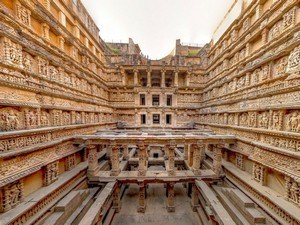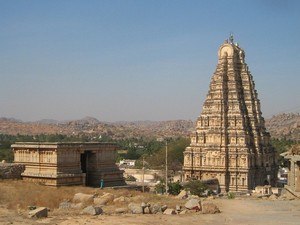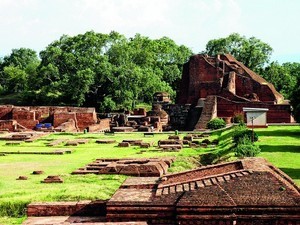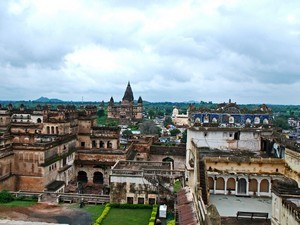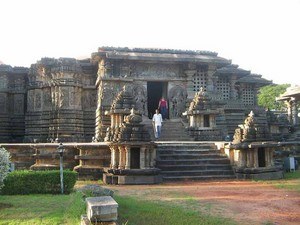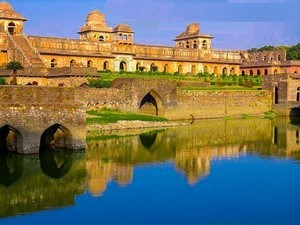1
DAY 1 : TRAVEL TO BADAMI & SIGHTSEEING
DAY 1 : TRAVEL TO BADAMI & SIGHTSEEING
 Sightseeing
Sightseeing
Leisure / No Sightseeing
At a distance of 1 km from Badami Bus Station, Cave 1 is a rock-cut cave situated in Badami, Karnataka. It is one of the must include places in Badami Tour Packages.
Badami Caves are carved out of a mighty red sandstone hill which is on the banks of Agasthya Lake. The first cave or Cave 1 is dedicated it Lord Shiva and it represents the Brahmanical style. Built in 550 AD, the cave has an L-shaped open courtyard in front, an open verandah, a pillared hall, and a sanctum excavated into the center of its rear wall. It is one of the places to visit in Badami.
The cave is famous for its fine sculptures. The most celebrated sculpture of the cave is that of Shiva as Nataraja with 18 arms and he is seen in 81 dancing postures of Bharata Natya. Another notable sculpture of the cave is Ardhanareeswara, a composite form of Shiva & Parvathi. On the other side .....
 Duration of visit: 15 Mins
Duration of visit: 15 Mins
 Timings: 9 AM to 5.30 PM
Timings: 9 AM to 5.30 PM
At a distance of 1 KM from Badami Bus Station, Cave 2 is situated just few meters above Cave 1 and it is dedicated to Lord Vishnu.
This is the smallest of four caves at Badami. Lord Vishnu is manifested as a dwarf or Trivikrama in this cave. Lord Vishnu is seen in the position of conquering the Earth by his one foot and ruling the sky with his other foot. The entrance of the cave has two guards or dwarapalakas holding lotus in their hands. Different forms of Lord Vishnu are portrayed here. The incarnations of Lord Vishnu are carved in this cave including Varaha and Lord Krishna riding a Garuda. Another highlight of the cave is the lotus encircled by 16 fishes.
The ceiling has the carvings of Anantasayana, Brahma, Vishnu, Shiva & other Ashtadikpalakas. The carving of celestial couple on the ceiling is attractive. Another puzzle like carving on the roof with couples on four sides is interesting. The wall brackets are finely carved with different puranic characters.
Timings: .....
 Duration of visit: 15 Mins
Duration of visit: 15 Mins
 Timings: 9 AM to 5.30 PM
Timings: 9 AM to 5.30 PM
At a distance of 1 KM from Badami Bus Station, Cave 3 is situated few more steps above Cave 2. This is the biggest and most attractive part of all four cave temples. Dating back to 578 AD, the cave has paintings and sculptures of both Lord Shiva and Lord Vishnu.
The cave can be reached through a plight of rock-cut steps and a large stone entrance. The inscriptions in this cave indicate that it was built by Mangalesha. The third cave is about 70 feet wide and it is a fine example of artwork of Badami Chalukyas. The delicate creativity and image astuteness are the prominence of the cave showcasing the ancient art. The art depicting ancient dresses, jewelry, hairstyle and the lifestyle of the glorious past will leave one mesmerize.
The sculpture of Trivikrama, a larger version of the one seen in Cave 2 is seen here. Images of Lord Vishnu manifested in many forms are seen here - Varaha, with Serpent, Vishnu as Narasimha, Vishnu as Trivikrama. The cave has wonderful bracket figures .....
 Duration of visit: 15 Mins
Duration of visit: 15 Mins
 Timings: 9 AM to 5.30 PM
Timings: 9 AM to 5.30 PM
At a distance of 1 KM from Badami Bus Station, Cave 4 is situated towards the east of Cave 3 and it was built in the 8th century. The Cave is dedicated to Jain Thirthankaras.
The main attraction of the cave is the sculpture of Lord Mahavira adoring the shrine along with the images of Padmavathi and other Thirthankaras. Mahavira, the 24th Jain Tirthankara is depicted in a sitting posture and Tirthankara Parshwanatha is carved with a serpent at his feet.
The cave is small in size but all the corners of the cave are finely carved with different Thirthankaras of Jain faith. The pillars have fine carvings of different characters and garland shaped designs. The wall brackets and the side walls of Mahavira and Parshwanatha carvings have small carvings of interesting images.
From the location of Cave 4, you can capture a breathtaking view of Agastya Lake, Badami Fort and Badami town.
Timings: 9 AM to 5.30 PM
Entry Fee: Rs. 10 for Indians, Rs. 100 for Foreigner .....
 Duration of visit: 15 Mins
Duration of visit: 15 Mins
 Timings: 9 AM to 5.30 PM
Timings: 9 AM to 5.30 PM
At a distance of 5 Kms from Badami, Banashankari Temple is located at Cholachagudda. Dedicated to Banashankari Devi, an incarnation of Goddess Parvati, it's one of the famous temples in the district.
The original temple was built in 8th century, believed to be by Rashtrakutas, but the present structure traces its origin in the 17th century. This temple represents a combination of Dravidian & Nagara temple architecture. Haridra Tirtha, a large temple pond with a tall lamp tower built on a three story structure is situated opposite to the entrance of the temple and it's a delight to watch. The entire pond is surrounded by a corridor built with stone.
The Goddess can be seen seated on a growling lion and crushing a demon with her foot. The idol is carved out of a black stone. The Goddess Banashankari is depicted here with eight arms sitting on a roaring lion. The temple features three large lamp polls in the main compound. These lamp polls are lit during special occasions and .....
 Duration of visit: 1-2 Hours
Duration of visit: 1-2 Hours
 Timings: 6 AM to 1 PM & 3 PM to 9 PM
Timings: 6 AM to 1 PM & 3 PM to 9 PM
2
DAY 2 : PATTADAKAL - AIHOLE SIGHTSEEING
%%Itinerary_Title_Day2%%
 Sightseeing
Sightseeing
At a distance of 1 km from Pattadakal Bus Stand, Jain Temple is an ancient temple situated in Pattadakal. It is one of the prominent places to visit in Pattadakal.
The Jaina Temple was built during the 9th century, possibly with sponsorship from the Rashtrakuta King Krishna II or the Kalyani Chalukyas. Unlike the other nine temples of Pattadakal, the Jain Narayana Temple lacks Hindu deities and intricate panels like the other nine temples but instead has a statue of a Jina carved into the north side kapota eave.
Built-in Dravidian style, the temple has a large Mukha mandapa followed by Rangamandapa and sanctum. Built on an elevated platform, the Mukha mandapa has 16 round-shaped pillars. The life-size elephant statues on both sides of the doorway welcome the tourists. The Mukha mandapa has stone benches with back support. The outer walls of the back support have nice carvings of human figures, .....
 Duration of visit: 30 Mins
Duration of visit: 30 Mins
 Timings: 8 AM to 6 PM
Timings: 8 AM to 6 PM
At a distance of 300 meters from Pattadakal Bus Stand & Temple Complex entrance, Kadasiddeshwara Temple is the first temple you encounter in the temple complex. It is a small 8th century structure built in Nagara style.
Kadasiddeshwara Temple is relatively small with a sanctum and hall built on an elevated platform. There is a fine sculpture of Lord Shiva and Parvathi. At the entrance, nicely carved dwarapalakas welcome the tourists. The upper part of the outer wall has good carvings of dwarf figures and birds. The outer wall of the sanctum has beautiful sculptures of Ardhanareeswara, Shiva and Harihara.
Complex Timings: 9 AM to 5 PM
Entrance: Rs. 10 for Person, & Rs. 25 for Camera
 Duration of visit: 15 Mins
Duration of visit: 15 Mins
 Timings: 9 AM to 5 PM
Timings: 9 AM to 5 PM
At a distance of 300 meters from Pattadakal Bus Stand, Galaganatha Temple is a historical temple situated ahead of Sangameshwara Temple inside the Pattadakal temple complex. It is one of the must visit places as part of Pattadakal Tour Packages.
Galaganatha Temple is a beautiful temple constructed at the beginning of the 8th century. Dedicated to Lord Shiva, the temple is built in Nagara style with a linga, and a vestibule (antarala) within the temple sanctum. Outside the temple is a seated Nandi that faces the sanctum. The entrance to the mantapa is flanked by the river goddesses Ganga and Yamuna. The architecture of the temple is the resemblance of Sangameswara Temple at Alampur in Telangana State.
The Galagatha temple is mostly in ruins, except for the southern part which contains a carved slab showing an eight-armed Shiva killing the demon Andhaka while wearing a garland of skulls as a yajnopavita (sacred thread .....
 Duration of visit: 15 Mins
Duration of visit: 15 Mins
 Timings: 9 AM to 5 PM
Timings: 9 AM to 5 PM
At a distance of 300 meters from Pattadakal Bus Stand, Jambulinga Temple situated behind Galaganatha Temple inside the temple complex is a small shrine constructed in 7th century.
The temple is constructed in Nagara style with sanctum and a small mandapa. This temple is constructed in the lines of Huchchimalli Temple in Aihole, but small in size. The sukanasi of the temple has a carved image of Lord Shiva with Parvathi. The temple is built on a high plinth having five moldings with decorated miniature ganas and birds.
The walls of the sanctum have sculptures of Siva, Surya and Vishnu.
Complex Timings: 9 AM to 5 PM
Entrance: Rs. 10 for Person, & Rs. 25 for Camera
 Duration of visit: 15 Mins
Duration of visit: 15 Mins
 Timings: 9 AM to 5 PM
Timings: 9 AM to 5 PM
At a distance of 300 meters from Pattadakal Bus Stand, Sangameshwara Temple situated between Galaganatha and Virupaksha temples inside the temple complex is the oldest temple in Pattadakal. It was commissioned by Chalukyan ruler Vijayaditya in the year 720 AD, but it seems the construction was never completed. Dedicated to Lord Shiva, this temple is similar to Virupaksha Temple in style but a smaller size.
The two tier Dravidian type sikhara is an experiment stared here which was implemented in ]temples of Virupaksha and Mallikarjuna and still being followed in South India. The temple has two entrances on north and south. The large rangamandapa with 20 pillars is partially ruined and there are two sub shrines for Mahishasura Mardhini & Ganesha. There is a ruined Nandi mandapa in front of the temple. The sanctum has a circular path for pradakshinas. There are few good sculptures on the outer wall like those of Ugranarasimha & Nataraja.
There are inscriptions on the temple .....
 Duration of visit: 15 Mins
Duration of visit: 15 Mins
 Timings: 9 AM to 5 PM
Timings: 9 AM to 5 PM
At a distance of 400 meters from Pattadakal Bus Stand, Virupaksha Temple is an ancient Hindu shrine located in Pattadakal, Karnataka. It is the biggest and most ravishing of all temples in Pattadakal, and among the must include places in Pattadakal Tour Packages.
Dedicated to Lord Shiva, Virupaksha Temple is the only functioning shrine in the temple complex, and among the popular places to visit in Pattadakal. The temple was constructed in 745 AD by the Chalukyan ruler Vikramaditya's consort Queen Lokamahadevi to commemorate his victory over Pallavas of Kanchi.
Built in the Dravidian style of architecture, the temple has three mukhamandapas on three sides with a large stone gateway on the East towards Malaprabha River. A large pillared hall is following by a sanctum with a circular path for pradakshinas. The mukhamandapas and the pillars .....
 Duration of visit: 30 Mins
Duration of visit: 30 Mins
 Timings: 9 AM to 5 PM
Timings: 9 AM to 5 PM
At a distance of 400 meters from Pattadakal Bus Stand, Mallikarjuna Temple is another grand temple in Pattadakal situated just beside Virupaksha Temple inside the temple complex. Dedicated to Lord Shiva, this temple is similar to Virupaksha Temple in architecture but little smaller in size.
The temple is constructed in 745 AD by the second wife of Chalukyan ruler Vikramaditya. Built in Dravidian style, the temple has three mukhamandapas on three sides with a partially collapsed stone nandi mandapa in front of the temple. A large pillared hall is following by sanctum. The mukhamandapas and the pillars of the hall have wonderful carvings of gods and scenes from Ramayana, Mahabharata and Panchatantra. The ceiling of the temple is also adorned with beautiful figures.
Some of the famous carvings in Mallikarjuna Temple include Mahishasuramardhini chasing demon, Gurukula, scenes from Mahabharata and Ramayana Wars, scenes from Yashodhara Charitha, Royal Lady, Kama and Vasantha, Monkey .....
 Duration of visit: 15 Mins
Duration of visit: 15 Mins
 Timings: 9 AM to 5 PM
Timings: 9 AM to 5 PM
At a distance of 400 meters from Pattadakal Bus Stand, Kashi Vishwanatha Temple situated adjacent to Mallikarjuna Temple inside the temple complex is a wonderful 8th century temple built in Nagara style.
This is believed to be the last Hindu temple built in Pattadakal monuments. The temple has only sanctum and antarala left and the remaining parts are collapsed. The sanctum is supported by two pillars and has a Shivalinga carved out of black stone. The doorway of the sanctum has a carving of Garuda holding snakes. Bottom of the doorway has nice sculptures of female figures in different postures.
The pillars of the temple have nice carvings with great details. One of the pillars has a nicely engraved image of Siva-Parvathi marriage and another one with Krishna Leela from Bhagavatam. Other images on the pillars include Ravana lifting Kailasa, Lord Shiva chasing demo Tripurasura
There are also few pillar reliefs of men riding mythical animals. The ceiling has a large .....
 Duration of visit: 15 Mins
Duration of visit: 15 Mins
 Timings: 9 AM to 5 PM
Timings: 9 AM to 5 PM
At a distance of 700 meters from Pattadakal Bus Stand & Temple Complex entrance, Papanatha Temple is a large structure built on the banks of Malaprabha River outside the main temple complex. This temple can be reached by walking down along the river bed from Virupaksha Temple gateway. This temple is dedicated to Muktewara, a form of Lord Shiva.
Built in a mix of Nagara and Dravidian architecture, this temple dates back to 680 AD. The vimana on top of the sanctum in built in nagara style, while the mukhamandapa facing east, rangamandapa and antarala are acquired from Dravidian style. The sanctum has a narrow circumambulatory path for pradakshinas. On three sides of the outer walls of sanctum, there are pillared porticos with sculptures of dancing Shiva.
This temple is famous for the carvings of scenes from Ramayana and Mahabharata. The sabhamandapa has 16 pillars with medium size sculptures of men & women. There is also a sculpture of Mahishasura Mardhini with 8 hands.
The .....
 Duration of visit: 30 Mins
Duration of visit: 30 Mins
 Timings: 9 AM to 5 PM
Timings: 9 AM to 5 PM
At a distance of about 2.5 Kms from Aihole Bus Stand & Durga Temple Complex, Galaganatha Temples are a group of about 30 temples situated on the banks of Malaprabha River.
Dedicated to Lord Shiva, the complex has several medium and small temples. Built in Dravidian and Nagara styles, some of the temples have a Shivalinga though no active poojas are done here. One of the temples has a large hall with Nandi and Shivalinga in the sanctum. Pillars in the hall are nicely carved in round shape with several wonderfully engraved images of gods at the bottom of pillars. The hall and sanctum are separated by richly designed lattice windows.
To reach Galaganatha Temple Complex from Aihole, you have to go towards Pattadakal for 2 km and take diversion to the right towards the river and driver for 500 meters.
The complex is open till 6 PM.
 Duration of visit: 30 Mins
Duration of visit: 30 Mins
 Timings: 6 AM to 6 PM
Timings: 6 AM to 6 PM
At a distance of 100 m from Aihole Bus Stand, Durga Temple, also known as Fort Temple, is an ancient Hindu shrine situated at Aihole, Karnataka. It is one of the most famous places to visit in Aihole with striking architecture and wonderful carvings.
Dedicated to the goddess Durga, the Durga Temple is located inside the main enclosed complex of Aihole monuments. The name of the temple is originated from a fortification (durgam) that existed around the temple earlier. It is one of the main places to visit as part of Aihole tour packages.
Build between the 7th and 8th centuries by Chalukyas, the temple plan in U shape resembles that of Buddhist Chaitya halls. The temple has a mukha-mandapa, a sabha-mandapa, and an inner sanctum with Shiva linga. The unique part of the temple is the pillared corridor around the temple that allows pilgrims to take pradakshinas .....
 Duration of visit: 30 Mins
Duration of visit: 30 Mins
 Timings: 9 AM to 5 PM
Timings: 9 AM to 5 PM
At a distance of 200 m from the Aihole Bus Stand, the Archaeological Museum is a museum situated inside the Durga Temple complex, Aihole. It is one of the popular places to visit as part of Aihole tour packages.
Planned as a sculpture shed in 1970, the Archaeological Museum in Aihole was converted into a full-blown museum in 1987. The museum houses a good collection of artifacts from the Aihole, Pattadakal, and Badami regions. It is one of the must visit Aihole tourist places.
The museum consists of 6 galleries and an open-air gallery. The artifacts in the museum are dated between the 6th and 15th centuries. A variety of Ganesha sculptures, Saptamatrikas with archaic features, Nataraja, Ambika of Jaina affinity, an attractive sculpture of Bodhisatva, and a mutilated anthropomorphic figure of Megalithic period are some of the important exhibits.
One .....
 Duration of visit: 15 Mins
Duration of visit: 15 Mins
 Timings: 9 AM to 5 PM
Timings: 9 AM to 5 PM
At a distance of 200 meters from Aihole Bus Stand and 100 meters south of Durga Temple, Suryanarayana Gudi 7th / 8th century temple situated opposite to Ladkhan Temple.
Dedicated to God Surya, this temple is built in Rekhanagara style with curvilinear tower. The temple consists of a small mandapa with four pillars, rangamandapa with four tall pillars and 12 half pillars followed by the garbhagriha. The doorframe of the sanctum has an image of Garuda holding two snakes, Ganga, Yamuna and an image of Surya in seated posture.
The sanctum has a statue of God Surya. The sanctum also has four pillars inside, which is a peculiar design. The sikhara is partially damaged.
Complex Timings: 9 AM to 5 PM
Entrance: Rs. 5, Rs. 25 for camera.
 Duration of visit: 15 Mins
Duration of visit: 15 Mins
 Timings: 9 AM to 5 PM
Timings: 9 AM to 5 PM
At a distance of 200 meters from Aihole Bus Stand and 100 meters south of Durga Temple, Ladkhan Temple is the oldest temple in Aihole believed to be built in 5th century by first Chalukyan ruler Pulakesi I. It is located inside the main enclosed complex of Aihole monuments. The temple is built in Mandapa style with plan roof.
Dedicated to Lord Shiva, the temple name is originated from Ladkhan, a Muslim general from Bijapur sultanate who stayed in the temple during their invasion of the region. Originally a Surya temple, the temple has a mukha-mandapa and a large sabha-mandapa. There is no separate garbhagriha in the temple and a stone booth is added to house the deity.
The large pillars in the mukhamandapa have beautiful carvings of gods along with floral designs. The outer walls are also exhibit extensive designs of early Chalukyas. The sabhamandapa has a big bull at the center. Large plain pillars support the sabhamandapa. .....
 Duration of visit: 15 Mins
Duration of visit: 15 Mins
 Timings: 9 AM to 5 PM
Timings: 9 AM to 5 PM
At a distance of 200 meters from Aihole Bus Stand and 100 meters south of Durga Temple, Goudaragudi Temple is one of the oldest temples in Aihole assigned to 5th century. It is situated beside Ladkhan Temple.
This temple is built in Madapa style on an elevated platform, few feet below the ground level of remaining temples. Dedicated to Mahalakshmi or Bhagavathi, the temple has a verandah supported by 16 pillars with slanting roof. The sanctum has circumambulatory path for pradakshinas. There are beautiful carvings of kalasha along the outer wall of the temple.
The entrance of the garbhagriha has image of Garuda and Gajalakshmi with four elephants above. The roof has a square platform, larger than the one seen on top of Ladkhan temple without any image.
Complex Timings: 9 AM to 5 PM
Entrance: Rs. 5, Rs. 25 for camera.
 Duration of visit: 15 Mins
Duration of visit: 15 Mins
 Timings: 9 AM to 5 PM
Timings: 9 AM to 5 PM
At a distance of 300 meters from Aihole Bus Stand and 200 meters south of Durga Temple, Chakra Gudi is a 9th century temple on southern end of Durga Temple Complex.
Dedicated to Lord Shiva, the temple sikhara is built in Nagara style with a large mandapa of round pillars. The temple accompanies few good carvings on the doorway and the seating stones near entrance of the temple. The doorway has an image of Garuda holding two snakes. The temple sikhara is intact and attractive.
There is a pushkarini (temple tank) beside the Chakra Gudi.
Complex Timings: 9 AM to 5 PM
Entrance: Rs. 5, Rs. 25 for camera.
 Duration of visit: 15 Mins
Duration of visit: 15 Mins
 Timings: 9 AM to 5 PM
Timings: 9 AM to 5 PM
At a distance of less than 100 meters from Aihole Bus Stand, Ambigera Gudi Complex is a group of three temples situated opposite to Durga Temple complex. The temple got its name from Ambiger (boatsmen) who used to live near the temple.
The complex has one main temple in ruined state with two small shrines. The main temple, believed to be a 10th century monument, has a nagara style sikhara with a mandapa and sanctum. The mandapa has two entrances and the ceiling of mandapa has a lotus image engraved. Built on elevated platform, the temple has a carved doorframe for the sanctum.
The second temple is a small one with broken images of Surya and Vishnu. The third temple is a small ordinary temple without any carvings and images.
This temple is open till 6 PM.
 Duration of visit: 15 Mins
Duration of visit: 15 Mins
 Timings: 8 AM to 6 PM
Timings: 8 AM to 6 PM
At a distance of 300 meters from Aihole Bus Stand & Durga Temple Complex, Jyotirlinga Temples are a group of monuments in ruined state. It is situated on the way to Meguti Jain Temple.
Dedicated to Lord Shiva, the complex has several small to medium temples, most of them in ruined state. The complex also houses a large stepped temple tank. Several temples still have Shivalinga, though no active poojas are performed here.
The unique feature of this complex is a wonderful set of Nandi mandapas. The pillars of the mandapas are richly carved with images of different gods. There are several mandapas lined in different directions with images of Shiva, Ganesha, Karthikeya, Ardhanareeswara among others.
There are few small temples built in Phamsana style, probably constructed during Rashtrakutas rule of the region.
This temple is open till 6 PM.
 Duration of visit: 15 Mins
Duration of visit: 15 Mins
 Timings: 8 AM to 6 PM
Timings: 8 AM to 6 PM
At a distance of about 800 meters from Aihole Bus Stand & Durga Temple Complex, Ravanapahadi is a wonderful rock-cut cave temple situated towards north-east side of Durga Temple.
Built in 6th century, the cave temple is dedicated to Lord Shiva. The exterior of the cave is simple with 4 pillars and dwarapalakas. The inner part of the cave has a rectangular verandah followed by a square hall and a garbhagriha. The major attraction of the cave is a carving of Lord Shiva with 10 hands in different Bharatanatya postures (a similar figure with 18 hands can be seen in Cave 1 of Badami).
The other important carvings in the cave include Mahishasura Mardhini, Varaha carrying Bhudevi, Lord Shiva & Parvathi. The inner hall of the cave is mostly plain and the garbha-griha has a monolithic Shivalinga. Outside the cave, there is a platform with nicely carved Nandi. There are two stone mandapas outside the cave on both sides of the entrance.
This temple is open till 6 PM.
 Duration of visit: 15 Mins
Duration of visit: 15 Mins
 Timings: 8 AM to 6 PM
Timings: 8 AM to 6 PM
At a distance of about 600 meters from Aihole Bus Stand & Durga Temple, Huchchimalli Temple is a well preserved temple close to Ravanapahadi (200 meters).
Believed to have been built around 6th to 8th century, the temple is dedicated to Lord Shiva. The temple is built on an elevated platform with a small mukhamandapa, a sabhamandapa and a gabha-griha. The doorframe has images of Garuda, Ganga, Yamuna, Elephant and amorous couple. The temple also has nice carvings of Brahma, Shiva, Vishnu and Gandharvas. The sabhamandapa has images of Indra, Yama and Kubera. The sabhamandapa and garbhagriha are separated by lattice window designs. The ceiling has an image of Karthikeya riding peacock.
The rekhanagara temple tower has images of Brahma and Surya and both sides. The temple also has a nice stepped temple tank. The walls of the tank have some beautiful images of Mahishasura Mardhini, Brahma, Vishnu, and scenes from the stories of Panchatantra.
There is a small temple in .....
 Duration of visit: 15 Mins
Duration of visit: 15 Mins
 Timings: 8 AM to 6 PM
Timings: 8 AM to 6 PM
At a distance of about 500 meters from Aihole Bus Stand & Durga Temple Complex, Mallikarjuna Temples are a group of temples situated on the way to Meguti Jain Temple past Jyotirlinga Temple Complex.
The complex has several temples build in different styles ranging from small to medium. Some of these temples are preserved while a majority of them are still in ruins. Excavation and restoration work is going on for several temples.
The complex features few unique structures. One of the Phamsana style temples built on an elevated platform has a roof sliding down through the sikhara to entrance. One temple with collapsed sikhara has a small mukhamandapa which is closed on one side. The mukhamandapa and rangamandapa of the temple are separated by lattice design windows.
There is a wonderfully built gateway in the center of the complex. There are also several large pillars scattered around the complex. The complex also comprises a large stepped temple tank in great condition.
The .....
 Duration of visit: 15 Mins
Duration of visit: 15 Mins
 Timings: 8 AM to 6 PM
Timings: 8 AM to 6 PM
At a distance of 800 meters from Aihole Bus Stand & Durga Temple Complex, Meguti Jain Temple is situated inside the fortified walls of Aihole fort on a hillock (past Buddhist Temple) south-east of Durga Temple Complex.
Constructed in 634 AD, Meguti Jain Temple is the only dated monument in Aihole. The temple has very valuable inscription in the form of poetry from the reign of Pulakesi II. The temple has two levels, ground level with a large pillared mukhamandapa with empty inner sanctum and a small shrine on top of it which can be reached through steps. The temple has seated figures of Jain teerthankaras. The construction of the temple appears to be incomplete.
One can have a panoramic view of the entire Aihole village and all the monuments of Aihole from the hilltop. The hill is supposed to be the site of Aihole Fort, but except the walls, none of the structures survive today.
From main road, the temple can be reached .....
 Duration of visit: 30 Mins - 1 Hr
Duration of visit: 30 Mins - 1 Hr
 Timings: 8 AM to 6 PM
Timings: 8 AM to 6 PM
3
DAY 3 : BADAMI SIGHTSEEING & TRAVEL TO BANGALORE
%%Itinerary_Title_Day2%%
At a distance of 1 Kms from Badami Bus Station, The Agastya Lake (Tirtha) is a huge lake located beneath the cave temples. Constructed in 5th century, the lake is considered holy due to the healing powers of its water.
The eastern banks of the Agasthya Lake are dotted with Bhoothanatha temples while the caves temples are located on South West part and the fort on North West end. According to puranas, The Pushkarini was a pleasure tank of God in Vaikunta, and is a beloved of Lakshmidevi and Bhoodevi. The Pushkarini was brought and set here by Garuda, the vehicle of Lord Vishnu. A bath in it is believed to destroy all sins.
The lake is usually crowded by the village residents for washing cloths and bath. The quality of water is okay but not a good place to swim. The surroundings of the lake provide great views of the hills surrounded by the historical monuments. The Bhoothanatha temple which is emerged into the lake is a beautiful sight with a backdrop of large hillock.
 Duration of visit: 15 Mins
Duration of visit: 15 Mins
 Timings: 9 AM 5 PM
Timings: 9 AM 5 PM
At a distance of 1 Kms from Badami Bus Station, the Archeological Museum is located at the foothills of Badami Fort on northern banks of Agasthya Lake. Established in 1976, the museum is a treasure of pre-historic artifacts of the region including stone implements, sculptures, architectural parts, inscriptions, etc, dating from 6th to 16th century AD.
At the entrance of Museum, Shiva's bull welcomes the tourists. The museum has four galleries, an open air gallery in the veranda and an open air gallery in front. The galleries house excellent examples of local sculptures; the highlights include the notable Krishna panel, and other panels depicting scenes from the Ramayana, Mahabharata & Bhagwad Gita. One of the galleries has a scaled model of a pre-historic cave, copies of faded murals from Cave 3.
Photography is prohibited in the museum.
Timings: 9 AM to 5 PM. Closed on Fridays.
 Duration of visit: 30 Mins
Duration of visit: 30 Mins
 Timings: 9 AM to 5 PM. Closed on Fridays.
Timings: 9 AM to 5 PM. Closed on Fridays.
At a distance of 1.5 Kms from Badami Bus Station, Mallikarjuna Group of Temple is a set of temples dedicated to Lord Shiva. These temples are located within an enclosed compound just before Boothanatha Temple.
Built in Phamsana style (stepped pyramid), these temples were assumed to be constructed during Rashtrakutas and Kalyani Chalukyas. The outer walls of the temple are plain rock without any carvings. The tower of inner sanctom is built in typical Rashtrakuta style of architecture. The main shrine has a pillerd mukha madapa, an enclosed madhya mandapa followed by the inner sanctom. The inner walls and pillars are mostly plain.
Several smaller shrines are built to the eastern and nortern sides of the main temple. Most of them are closed for renovation.
 Duration of visit: 15 Mins
Duration of visit: 15 Mins
 Timings: 6 AM to 6 PM
Timings: 6 AM to 6 PM
At a distance of 1.5 km from Badami Bus Station, Boothanatha Temple is a magnificent structure situated on the banks of Agasthya Lake past Badami Museum in Badami. It is one of the must-visit places as part of Badami Packages.
Dedicated to Lord Shiva, Boothanatha Temple is the most striking structure of Badami and prime promotional element of Badami Tourism. The temple is surrounded by water on three sides. The temple was constructed in the early 8th century by Chalukyas. Constructed in Dravidian style, the temple is emerged into the Agastya Lake and becomes inaccessible during peak monsoons when the water level in the lake reaches the full capacity. The temple has a pillared mukha mandapa, sabha mandapa, and inner sanctum with a Shiva image. The main temple is accompanied by several small shrines on the northern and eastern ends.
The form of Bhoothnath is said to be the combination of the God of Soul, Spirit, and the Ghost. .....
 Duration of visit: 15 Mins
Duration of visit: 15 Mins
 Timings: 9 AM to 5 PM.
Timings: 9 AM to 5 PM.
At a distance of 1.5 Kms from Badami Bus Station and behind Badami Museum, Badami Fort is situated on top of a hill on the northern banks of Agasthya Lake, other side of Cave Temples.
The fort can be reached by a plight of steep steps from the museum. There are several decorated gateways build out the rock with carvings. The walkway to the fort was carved out from huge redstone hillock, providing unique setting to the fort. There are several water storage beds enroute the top. There are two temples inside the fort, well known as Lower Shivalaya and Upper Shivalaya. The Lower Shivalaya is a small two story structure on the corner of hill overlooking the Badami town. The Upper Shivalaya is a Dravidian style structure on top of the hill. There are several ruined structured all around the fort.
The fort provides magnificent views of all the monument of Badami, including Caves, Lake, Bhoothanatha temples and other monuments. Entire Badami town can be seen from the fort hill. Though .....
 Duration of visit: 30 Mins - 1 Hr
Duration of visit: 30 Mins - 1 Hr
 Timings: 9 AM to 5 PM. Closed on Fridays.
Timings: 9 AM to 5 PM. Closed on Fridays.

